Studio Visit
In an Old Tropical Plant Nursery, Lauren Quin Explores Kaleidoscopic Abstraction
The sought-after L.A. painter is letting her 'frenetic' new works play freely in an exhibition at 125 Newbury.
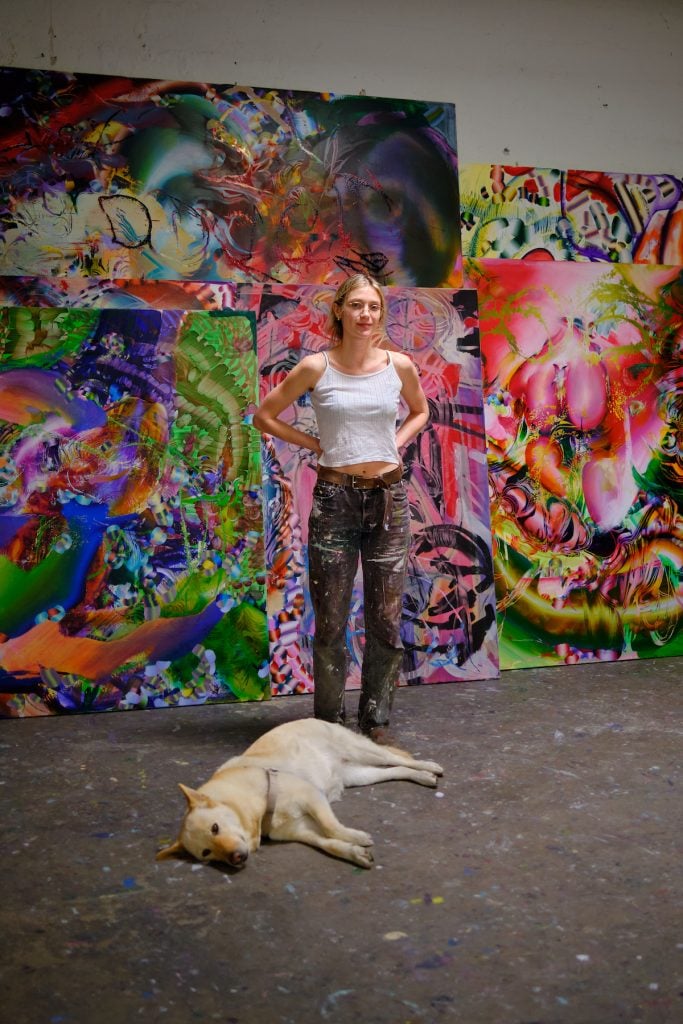
The sought-after L.A. painter is letting her 'frenetic' new works play freely in an exhibition at 125 Newbury.

Emily Steer

From her botanical studio in Los Angeles, Lauren Quin paints kaleidoscopic abstract works drawn from her own inner world, as well as the collective unconscious. Her vibrant layers are built up in a methodical fashion, before being scraped and carved into, rendering thick excavations in spidery marks across the canvas. She also monoprints onto the surface.
For “Logopanic”, her current exhibition at New York’s 125 Newbury, the project space helmed by Pace’s Arne Glimcher, the artist has created an entirely new body of work.
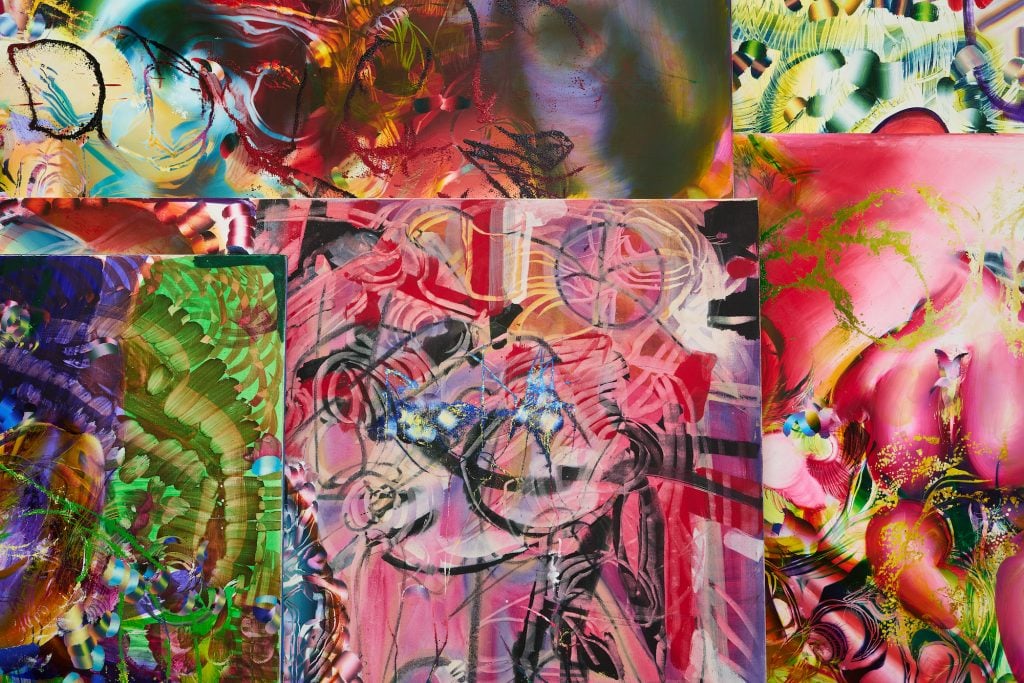
A selection of paintings in Lauren Quin’s studio.
Quin describes these pieces as occupying a “fugue state”, referencing the psychological phenomenon of temporary memory loss, when the mind seems to dissociate from the body for a period of time. This reflects her experience of painting as holding the risk of becoming lost; in her process she foregoes a fixed position in both space and language.
The title of the show references the Greek phrases “logos” (“word”) and “penia” (“poverty” or “lack”). Together, they evoke a loss of speech, or the absence of symbolism. Those searching for solid forms or meaning in her work may become disorientated themselves.
As the first part of the exhibition opened, Quin spoke about her studio’s former life as a plant nursery; experiments with rabbit skin glue; and the “frenetic nature” of her paintings.
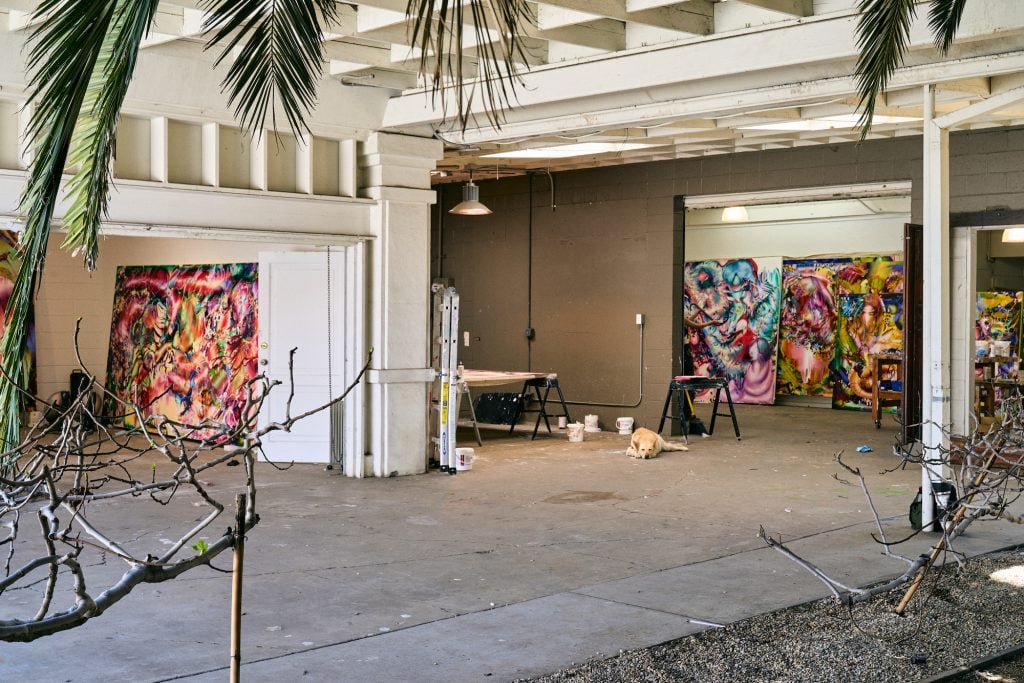
Lauren Quin’s L.A. studio.
Tell us about your studio. How does it compare to other studios you’ve had? Where is it and what kind of space is it?
My studio is in a large building in Los Angeles, right at the edge of West Adams and Culver City. It was previously a nursery for trees and cacti, so it has lots of skylights and fresh air. Over time, I’ve put in a shower and built out a little apartment area, but I’d still call it glamping. The first thing you see when you enter is the garden. There are six massive palm trees that are dropping dates all year long and at least ten fig trees, plus vines and a handful of Plumerias.
I have never had a green thumb, but they hardly need me. I am floored by how fast they grow. I can’t keep up with them. By the time I come home from New York, there will be piles of figs in the driveway. Naturally there’s fauna that shows up for all the flora too. I’ve had hummingbirds trapped in skylights and large lizards chilling out behind paintings. Thankfully, my dog chases away anything larger.
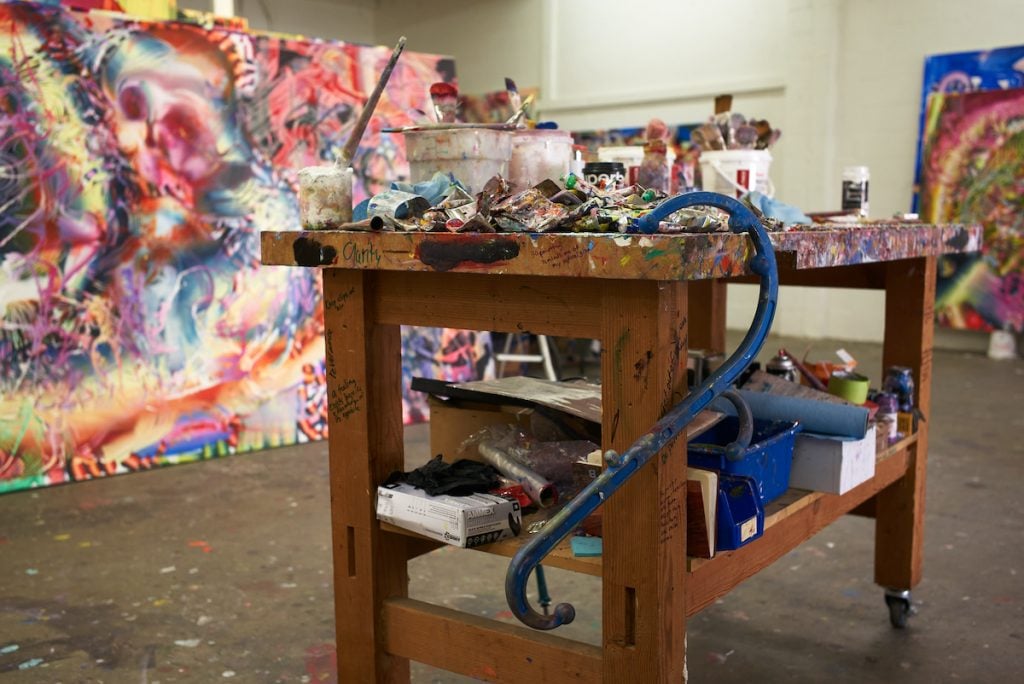
Lauren Quin’s L.A. studio.
You’ve just opened “Logopanic”, a new body of work at 125 Newbury. What can you tell us about the paintings that have gone into that exhibition?
The show is in two parts. This first iteration will be up for three weeks (until May 24), and the second installation will be a new set of works (after May 28). More than anything, Arne [Glimcher, founder and chairman of Pace Gallery] and I knew that we needed to preserve space in the installation, to let the frenetic nature of the paintings really play out. So we have some surprises in store for the people who keep looking.
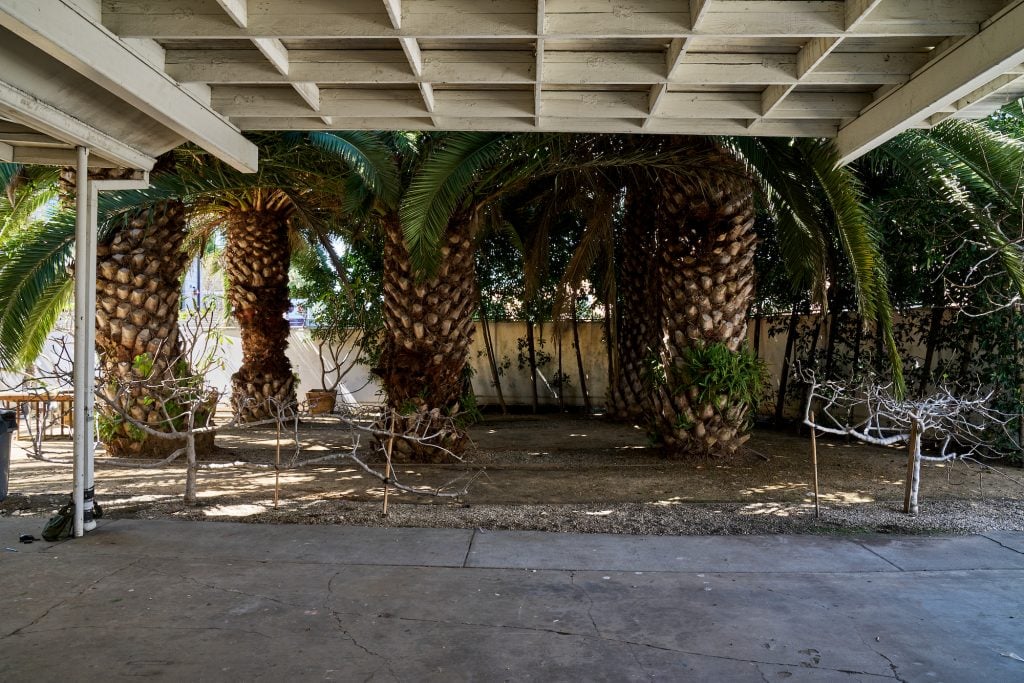
View of Lauren Quin’s studio.
What are you working on right now?
I just finished that show, so I need to take a beat to gather myself. I have been working in the Pace Prints shop during my stay in New York. For the moment, I’m happy to have a corner of the city to cancel out the noise.
Back in the studio, I’ve also been picking up rabbit skin glue again. I’ve worked with it before, but it’s been a long time. I would say it’s similar to making jello. I cook it up, and paint with it while the mixture is hot, and then I carve once the paint cools into its jelly state.
The glue cures into the grit of the canvas and it shows all the grain and indecision in each layer. When I incorporate a new medium, I have to reorder my thinking to accompany the nature of the paint. Acrylic is flat, oil is juicy, and glue is suspended in between them. Also, cooking paint in a large pot feels a bit witchy.
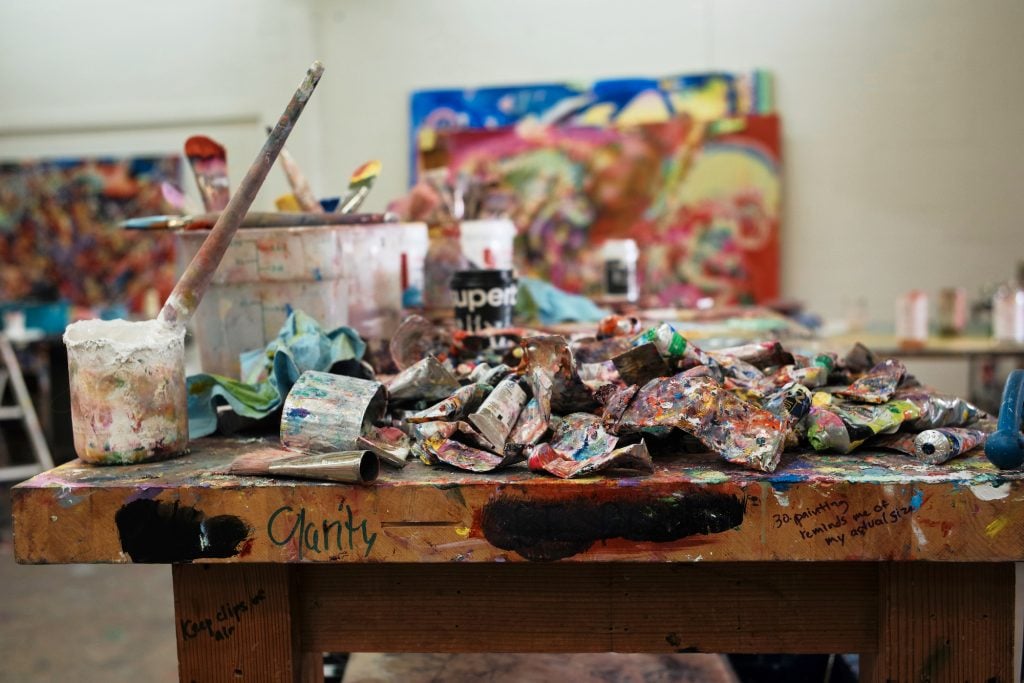
Lauren Quin’s L.A. studio.
What tool or art supply do you enjoy working with the most, and why?
Anything is a tool when you need it to be, but I have a whole hoard of pilfered cutlery in the studio. I have been using the same butter knife for the past four years. It’s the perfect weight and dull edge for carving into wet paint. I also use a spoon that has a unique peak at the end of it. Other utensils that have worked their way into the studio include boba straws and the small charcuterie knives.
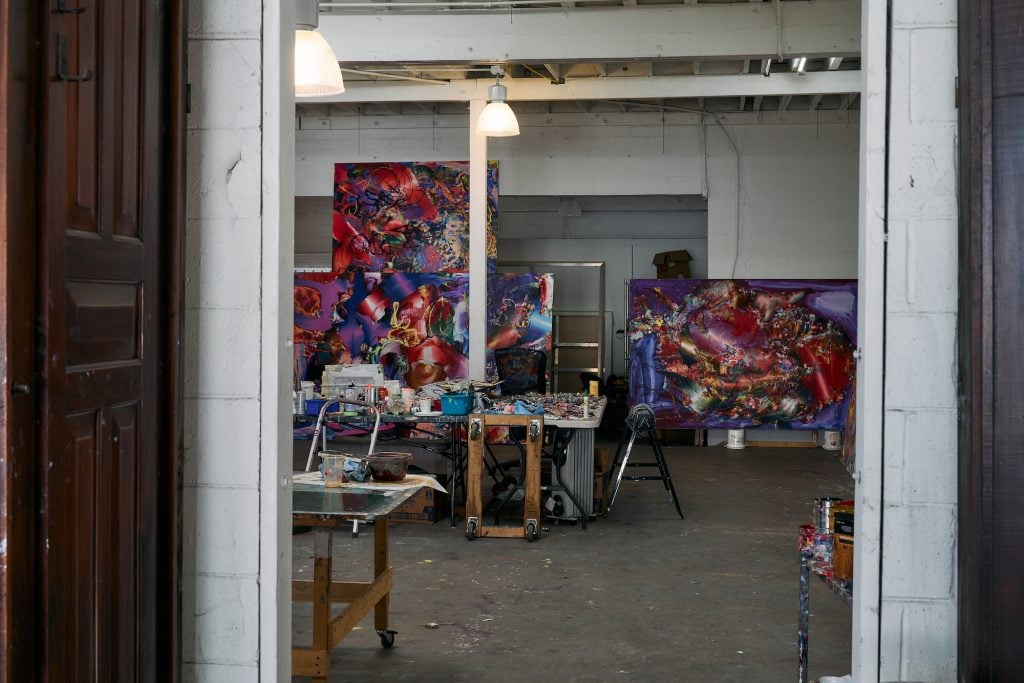
Lauren Quin’s L.A. studio.
When you feel stuck while preparing for a show, what do you do to get unstuck?
Running is my first unstick method. If everything goes according to plan, I try to get a run in after a studio day. A few months ago, I tried a bout of somatic therapy, where you hold handles that vibrate at a rhythm, or you tap opposite sides of your body. The therapy helped enough, and I won’t bare my soul too much on Artnet! I realized it served the same function as running. Just the rhythm of the impact from the ground up is enough for me. When I really need help, I will go for a run on the beach.